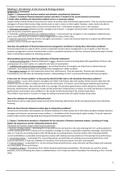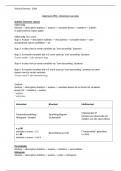Meeting 1: Introduction to the Course & Strategy Analysis
Assignment 1: Framework
Chapter 1: A framework for business analysis and valuation using financial statements
1. Chapter 1 introduces financial statement analysis and why it is needed in the current business environment.
A Under what conditions do information problems arise in a corporate setting?
Capital markets channel financial resources from savers to business ideas (investment opportunities). They are used by business
managers to finance their business ideas and by savers to earn a return on their capital. However, savers need to be able to
evaluate investment opportunities to finance the best ideas first. 3 information problems arise in this situation:
1. Information asymmetry between business managers and investors = managers will have better, inside information on the
value of business investment opportunities
2. Potentially conflicting interests and credibility problems = communication by managers is not completely credible because
savers know they have an incentive to inflate/exaggerate the value of their ideas
3. Expertise asymmetry between business managers and investors = savers lack financial expertise to analyse and differentiate
between various investment opportunities.
How does the publication of financial statements by management contribute to solving these information problems?
Financial statements are used to inform current or potential investors about management’s use of capital, so that they can
evaluate management’s actions and value their current or potential investment in the firm. Financial statements help to resolve
these 3 information problems by informing investors.
What problems persist even after the publication of financial statements?
1. Accrual accounting data in financial statements is noisy = because accrual accounting deals with expectations of future cash
consequences of current events, it is subjective and relies on assumptions
2. Credibility and quality of financial statements = accounting discretion of managers can allow them to distort financial
statements. Accounting standards and auditing limits management’s ability to distort.
3. Non-expert investors can only imprecisely assess firms’ performance. They lack expertise. Financial and information
intermediaries can add value by improving investors’ understanding of a firm’s current performance and future prospects.
B How does the ‘lemons-problem’ as discussed by Akerlof (1970) relate to the described information problems?
Lemon problem = occurs when business managers have better information about the quality of their business ideas than the
investors but are not able to credibly communicate this information. If investors cannot distinguish between good and bad
investment opportunities, they will value both at an average. This penalizes good business which will get less attractive
financing. Good business will leave the market and the proportion of bad business increases. As result, bad business crowd out
good business and investors lose confidence in the market and the functioning of the market breaks down.
This problem could result in investors no longer be willing to provide funds and capital markets break down
How is the valuation of companies affected by this?
Good business will be undervalued and get less attractive financing, bad business will be overvalued and get more attractive
financing.
What role does financial statement analysis play in solving these problems?
Financial and information intermediaries use financial statements to help resolve the 3 information problems between business
managers and investors and prevent lemon problem, i.e. breakdown of the functioning of capital markets. Financial statement
analysis helps investors distinguishing bad and good investment opportunities.
2. Chapter 1 furthermore introduces a framework for the execution of financial statement analysis, consisting of 4 steps.
Explain the importance and the relationship between them.
Framework for business analysis with financial statements:
1. Business strategy analysis = identifying firm’s key profit drivers and business risks and assessing the firm’s profit potential. It
involves analysing the firm’s industry and its competitive strategy to create a sustainable competitive advantage. Essential first
step, as it improves accounting analysis with identifying key accounting policies, financial analysis with evaluating whether
current profitability is sustainable and prospective analysis with making sound assumptions in forecasting future performance.
2. Accounting analysis = evaluating firm’s accounting policies and estimates and undoing any accounting distortions in the
financial statements. It improves reliability of conclusions from financial analysis, forecasts, and valuation.
3. Financial analysis = evaluating firm’s current and past financial performance using ratio and cash flow analysis and assessing
the sustainability of the performance.
4. Prospective analysis = forecasting a firm’s future financial performance and position. The forecasts are used for various
purposes, such as estimating firm value or creditworthiness. First 3 steps are used as foundation for estimating a firm’s intrinsic
value.
1
, Assignment 2: Externalities of Public Firm Presence: A Case for Disclosures
0.1 Externalities of Public Firm Presence: Evidence from Private Firms’ Investment Decisions. (Badertscher, Shroff & White,
2013)
Research question:
examines whether greater public firm presence in an industry increases the responsiveness of private firms to investment
opportunities by reducing uncertainty in the industry, i.e. positive externalities of the presence of public firms. Second, they
examine whether variation in the degree of investment irreversibility across industries influences this relationship.
This happens because public firms disclose a lot of information which financial analysts analyse and disseminate information,
which helps private firms in forming view of current economic environment and opportunities
Methodology:
Responsiveness to investment opportunities = measuring investment (change in gross fixed assets) to lagged sales growth
Quality of information = public firms and information intermediaries disclose more is better information quality (more analyst
coverage, management guidance etc.)
Conclusion:
Private firms are more responsive to their investment opportunities when they operate in industries with greater public firm
presence in the US. The effect is greater in industries with better information quality and in industries characterized by a greater
degree of investment irreversibility.
Because if irreversible firms are more cautious, and if information quality bad (less disclosures and dissemination) public firm
presence does not matter. Public firms’ disclosures generate positive externalities by reducing industry uncertainty and
facilitating more efficient private firm investment.
1. Explain the intuition behind the investment under uncertainty theory. How do the authors define investment efficiency?
Investment under uncertainty theory = when investment decisions are (partially) irreversible (investment expenditures partially
sunk, i.e. irrecoverable, less liquid assets), firms become cautious and hold back on investments in the face of uncertainty. This
leads to firms being less responsive/insensitive to investment opportunities.
Investment efficiency = the firm’s sensitivity to investment opportunities, for managers to pick the highest return-on-investment
opportunities they need information. If there is more uncertainty, managers will wait and see and potentially miss out on
valuable investment opportunities, i.e. be insensitive, which leads to inefficient investments.
2. What mechanisms make that greater public firms presence is associated with greater investment efficiency of private
firms?
Public firms disclose large amounts of information and information intermediaries analyse, discuss and disseminate this
information. This reduces the information uncertainty within an industry. Private firms in the US do not have to publicly have to
disclose information. Less information uncertainty within the industry allows firms within to make more informed investment
decisions.
If the role of information intermediaries (disseminate and analyse information) and the information quality is greater, then the
reduction in uncertainty will also be greater.
Why do the results hold in the US setting, but not the UK setting?
Because of the legal framework. Private firms in the US do not have to publicly have to disclose information, but they have to in
the UK. Therefore greater public firm presence in unlikely to have an effect on industry uncertainty. Because UK private firms do
have to disclose information, there is already less uncertainty.
Therefore, the composition of public and private firms in an industry in the US affects the information environment in that
industry.
3. How might public firm presence affect the usefulness of strategy analysis overall and industry analysis in specific?
The resulting less uncertainty allows a better understanding of the industry and the industry’s profit potential. It allows to better
evaluate the firm’s competitive strategy and its effect on the firm’s profitability, its key risks and sustainability of profitability.
Comparability between firms also increases.
4. Based on the results of the study, should (public firm) disclosures be mandatory?
Public disclosures help to provide a more comprehensive view of the industry, and facilitate more efficient investment. These
positive externalities support mandatory disclosure regulation for all firms.
Assignment 3: The Importance of Industry: Analysts’ Industry Expertise
0.2 Analysts’ Industry Expertise. (Kadan, Madureira, Wang & Zach, 2012)
Research question: examine whether sell-side analysts have industry expertise and if so which one?
Analysts exhibit across-industry expertise by industry recommendations generating abnormal returns over both short and long
horizons beyond what would be explained by industry momentum.
Methodology: They analyse returns of portfolios based on industry recommendations
2







